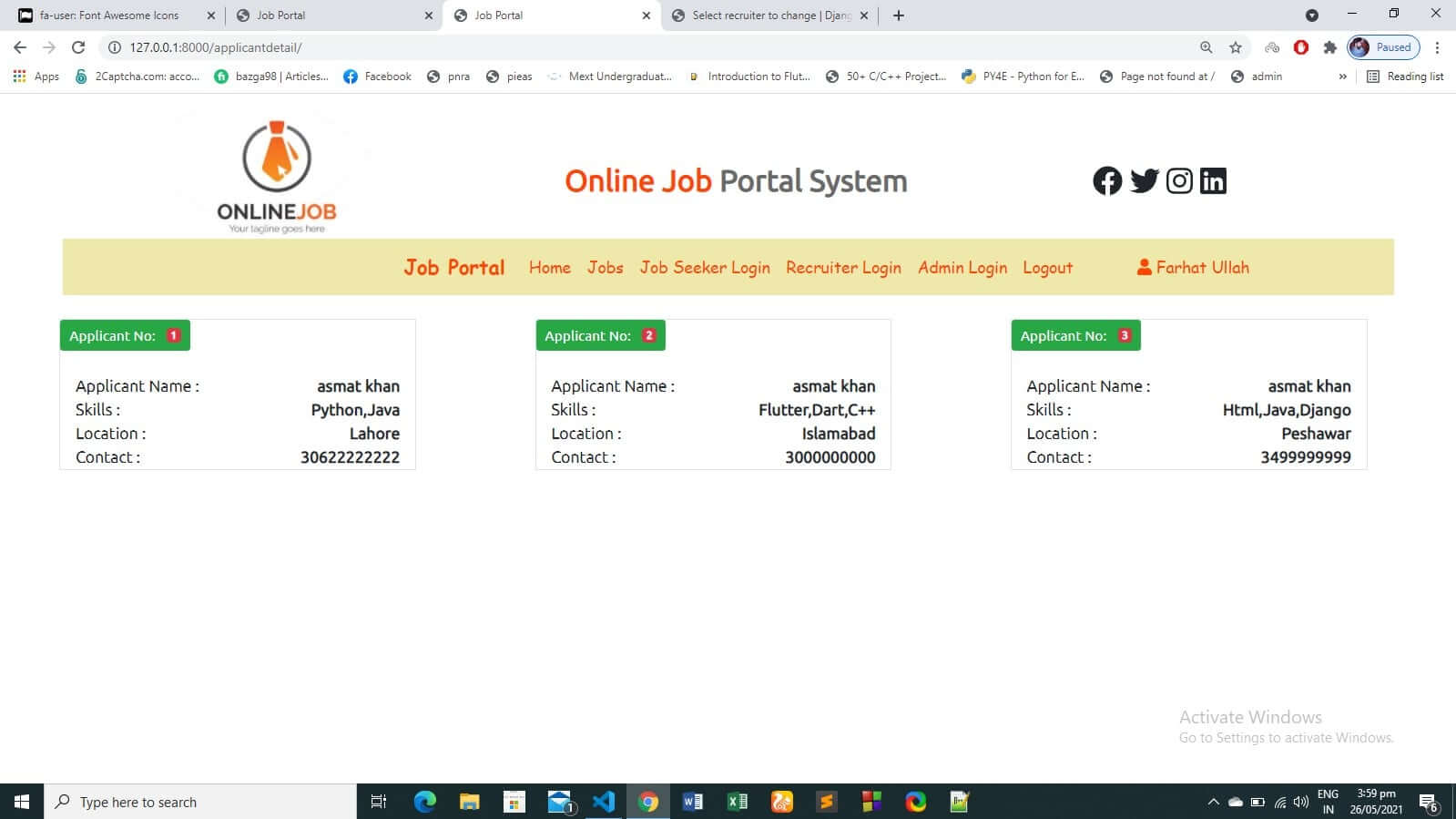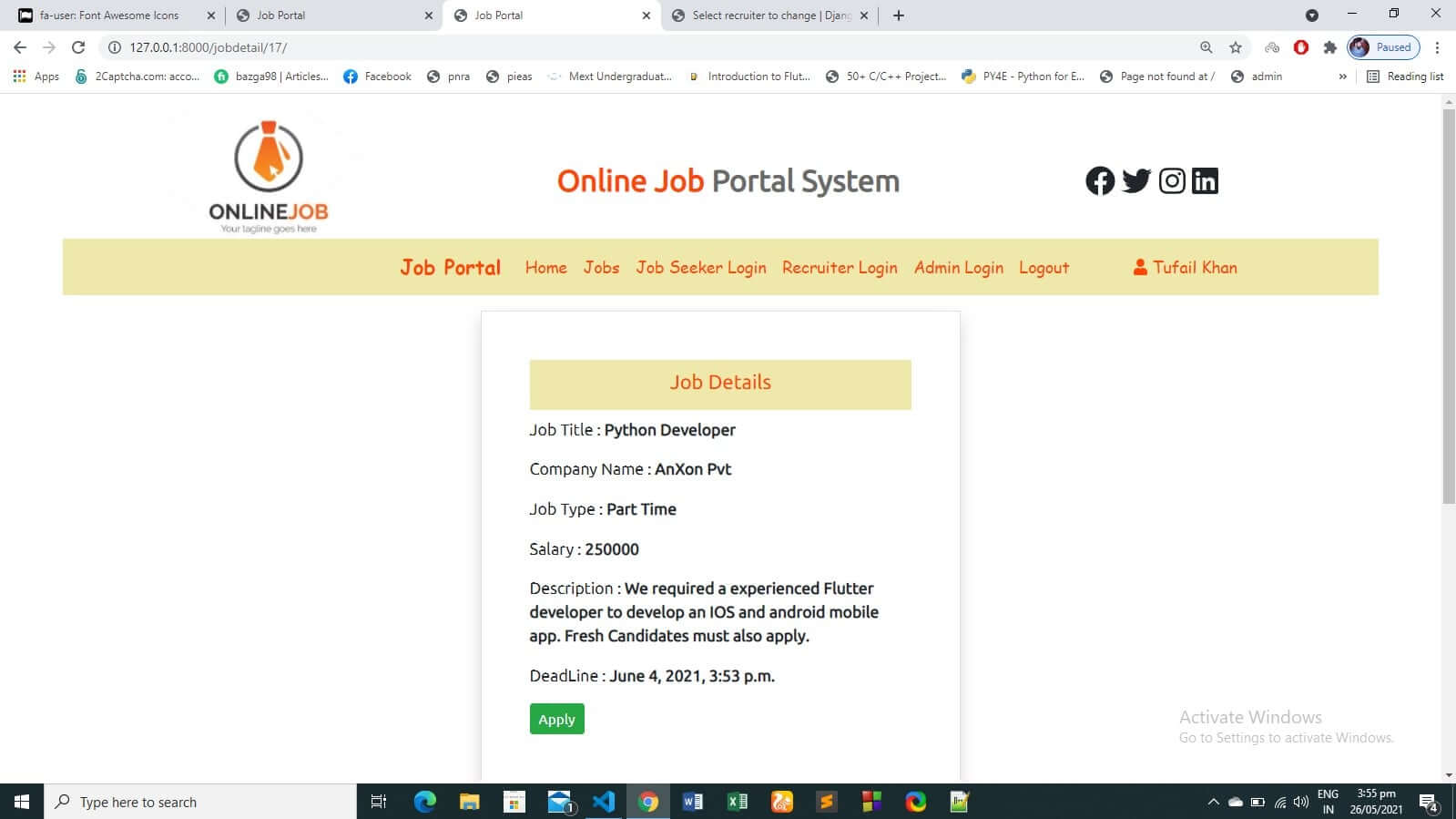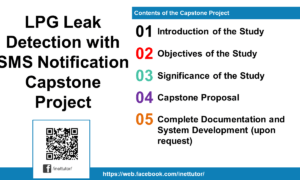Online Job Portal using Django Web Framework
Abstract
Table of Contents
Technology is always evolving, and individuals must adapt to these changes to compete. These developments are accompanied by changes in how people live their lives. The bulk of people in today’s society relies on technology to complete their work. Traditionally, job seekers look for job opportunities and vacancies on their own or through agencies, which takes time and effort. In the absence of a centralized platform, employers will have difficulty posting job vacancies and accommodating job applicants. This job-seeking and employment approach became obsolete with the advancement of technology. To that end, the researchers set out to create a Job Portal System that would digitally alter job search and employment processes. The online Job Portal System will be developed using the Django Web Framework. The job portal system is a system for users that eliminates or reduces manual job searching and allows for convenient and easy deployment of online marketing and advertising. Job seekers and candidates can use their computers and mobile devices that are linked to the internet to look for and apply for jobs. To provide a full and well-functioning system, the researchers will create the system using the Software Development Life Cycle (SDLC) technique. Job employers and job seekers are the system’s target users.
Introduction of the Study
The use of technology makes tasks and activities easier to do. It aids people and makes their lives easier and more convenient for them. The capstone project, entitled “Online Job Portal using Django Web Framework” is specifically designed for job employers and job seekers. From the convenience of their own homes, job searchers would be able to effortlessly look for job openings. Employers can also quickly and easily post information about open positions and the qualifications required for those jobs on the online job portal platform.
As the number of job searchers grows, the competition for jobs has gotten fierce. Traditionally, job seekers would look for job openings on their own or rely on employment agencies to find them. Applicants’ time and effort are wasted as a result of these wasteful practices. Employers, too, find it difficult to publicize their vacancies to a larger number of job searchers, where updates will be received quickly, which is tough. Without a centralized platform, employers will also face difficulties in accommodating job applications. This job-seeking and employment approach became obsolete with the advancement of technology.
Proposed Solution
As a response to the aforementioned concerns, the researchers of the study proposed the development of the Online Job Portal. The said initiative will be developed using Django Web Framework by the researchers. The job portal will ease up and simplify the process of posting and searching for job vacancies by job employers and job seekers, respectively. The said project will allow job applicants to browse for jobs electronically which is more convenient and fast. As for the employers, they can also easily fill in the gaps in their vacancies for they can advertise job hiring in a fast and efficient manner which will reach a wider range of job seekers. The said initiative will make job posting and seeking easy, fast, convenient, and efficient.
Objectives of the Study
General Objective – The main goal of the researchers is to design, develop and implement an Online Job Portal using Django Web Framework.
The researchers specifically aim the following objectives:
- To eliminate manual job-hunting procedures.
- To electronically transform advertisement of job hiring and vacancies.
- To empower job seeker with job searching tool that is efficient and reliable.
- To design a centralized platform that will streamline job hiring and job seeking.
- To evaluate the system in terms of user acceptability, functionality, portability, maintainability, productivity, and reliability.
Scope of the Study
This study only covers the documentation and the development process of the Online Job Portal developed using Django Web Framework. The system is only limited to the job posting and seeking related operations and transactions. It will allow both job employers and job seekers to register in the system. The job employers will advertise their job vacancies in the system which will allow registered job seekers to browse and apply. The target end-users of the system are companies, job employers, and job seekers.
Significance of the Study
The following individuals or groups will benefit from the study:
Employers. Employers will profit greatly if this study succeeds because it will make their jobs much easier. They can post and update information about vacancies and other information as needed.
Job Seekers. This will give them a quick way to look for work on the internet. They are free to submit and update their résumé as often as they wish. This technology would make it easier for job seekers to locate work swiftly.
Administrator. If these study results are satisfactory, this will enable the work of the administrator to be easier. The administrator can manage the entire system and maintain the profile of the applicants and employers smoothly.
Researchers. The project will further enhance their skills and knowledge in developing successful projects.
Future Researchers. The study will serve as their guide in developing their version of the Job Portal System.
Development Tools
The “Online Job Portal in Django Web Framework” capstone project aims to digitally revolutionize the job search and hiring processes. The system was created to modernize the traditional method of job searching and job postings.
The forms that will be included in the system will be discussed in this article. The template was created using PHP and Bootstrap.
On request, the project’s documentation is accessible (chapters 1 to 5). Please feel free to contact us if you would like to see the project’s entire documentation.
Project Highlights
The Django Web Framework’s Online Job Portal is a database-driven solution that streamlines job-related transactions. It will keep track of and display information on jobs, such as job openings and recruitment, which will be available to both job seekers and companies.
Advantages of the System can be classified into the following:
- Job Posting and Seeking Automation – It will be easier for job seekers and businesses to explore and publish job updates if they have a better understanding of how to do so.
- Records Management – It is a database system that makes the records electronic, secure, dependable, and quick.
- Automated report Generation – The system can generate real-time job status reports in real-time.
How the System Works
This article will focus on the discussion of the system’s features and functionalities. The researchers will go through a detailed presentation and explanation about the system’s forms, modules, and user interface.
Applicant Details – this module will allow the system administrator to manage the applicant’s details in the system. The admin can add, edit, update or delete information.
The following information will be encoded in the module:
- Applicant No.
- Applicant Name
- Location
- Contact
The image shown below is the design of the Applicant Details module in the system.

Job Details – this module will display the details of the job for hire in the system. The admin can add, edit, update or delete job information.
The following information will be encoded for the job details:
- Job Title
- Company Name
- Job Type
- Description
Shown below is the design of the Job Details module.

Visit our Facebook page and YouTube Channel for the complete screenshots.
FREE DOWNLOAD SOURCE CODE
Conclusion
The purpose of this study was to discover how job searchers and businesses now search for and post job openings. According to the initial investigation, job searchers continue to employ the manual way of searching for jobs on their own, which takes a lot of time and effort. Employers also face challenges in announcing job openings, which causes them to be delayed in filling them. It’s not the best way to go about it. As a result, the researchers created and presented a Job Portal System developed using Django Framework to the respondents and target users.
The study’s findings revealed that the produced system satisfied the respondents’ and the system’s intended users’ demands and requirements. In terms of user acceptability, functionality, portability, maintainability, productivity, and reliability, the respondents assessed the system as satisfactory. The system is a trustworthy and effective way to streamline job searching and hiring.
Recommendations
The researchers strongly propose that the method be implemented based on the study’s major findings. The method should be implemented for both job seekers and employers, according to the experts. It is advised that the system be used to streamline the process of searching for and posting job openings. The need of having sufficient knowledge on how to correctly operate the technology is also emphasized by the researchers.
The researchers’ precise recommendations are as follows:
- Job seekers should register in the system to conveniently browse and search for job openings, according to the study.
- Employers should think about using the system to quickly and easily send out job postings to job searchers who are looking for work.
- It is highly suggested that the system be implemented because it will make job searching and employment easier, faster, more convenient, and efficient.
You may visit our Facebook page for more information, inquiries, and comments. Please subscribe also to our YouTube Channel to receive free capstone projects resources and computer programming tutorials.
Hire our team to do the project.
Related Links and Articles:
Job Portal System Free Bootstrap Source code
TrabahoFinder Mobile and Web Application for Job Searching and Posting
Online Summer Job Inquiry System with SMS Notification
Online Job Application System with Job Matching Feature
Online Alumni Tracer and Job Portal System with SMS Notification
Job Portal System Form Design and System Features

